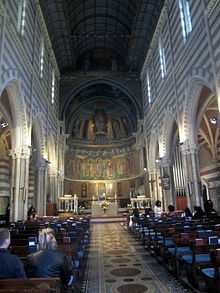St Paul's Within the Walls
| St Paul's Within the Walls | |
|---|---|
| American Church in Rome | |
| Italian: San Paolo dentro le mura | |
|
The west front | |
| Coordinates: 41°54′04″N 12°29′39″E / 41.90111°N 12.49417°E | |
| Denomination | Episcopal |
| Website |
www |
| Architecture | |
| Architect(s) | George Edmund Street |
| Style | Gothic Revival |
| Completed | 1880 |
St Paul's Within the Walls (Italian: San Paolo dentro le mura), also known as the American Church in Rome, is a church of the Convocation of Episcopal Churches in Europe on Via Nazionale in Castro Pretorio, Rome. It was the first Protestant church to be built in Rome.[1] Designed by English architect George Edmund Street in Gothic Revival style, it was built in polychrome brick and stone,[2] and completed in 1880.
The church contains mosaics which are the largest works of the English Pre-Raphaelite artist Edward Burne-Jones.[2]
Construction
Building a Protestant church in Rome became possible after the Kingdom of Italy's Capture of Rome from the Papacy in 1870.[2]
The Episcopal expatriate congregation in Rome commissioned Street in 1872. The cornerstone was laid in 1876,[2] and the church was completed in 1880.[3]
Mosaics

Street approached Burne-Jones in 1881, but died the same year. The congregation's rector, Robert J. Nevin, travelled to England to confirm and expand the commission.[4] Burne-Jones was eager to emulate the mosaics of Ravenna, which he had visited in 1873.[5]
Burne-Jones designed cartoons which he sent to Venice, together with specifications for the colours to be used. The Venice and Murano Glass and Mosaic Company mounted tesserae onto the cartoons, and the resulting assemblies were then installed in the church. The selection of colours, based on sample tiles sent to England by the company, was a collaboration between Burne-Jones and William Morris. Burne-Jones did not travel to Italy to supervise the work, instead sending his assistant, Thomas Rooke.[6]
There are four Burne-Jones mosaics. The Annunciation and The Tree of Life, both completed in 1894,[1] are over successive arches of the chancel, leading towards the apse, whose semi-dome displays Christ Enthroned in the Heavenly Jerusalem,[7] completed in 1885.[1] The fourth mosaic, known as The Earthly Paradise or The Church Militant, lower down on the wall of the apse, was completed in 1907 by Rooke, after Burne-Jones's death.[7]
Burne-Jones set the Annunciation scene in a desert, while The Tree of Life shows Christ in the pose of crucifixion but superimposed on a verdant tree. In the depiction of the Heavenly Jerusalem, Christ is flanked by archangels, with an empty space representing Lucifer's vacated position. The fourth mosaic includes figures with faces modelled on contemporary people.[7]
The church also contains mosaics by the American artist George Breck.[3]
See also
- All Saints' Church, Rome (Anglican, also by G. E. Street)
- American Church in Paris
- American Church in Berlin
Notes
- ↑ 1.0 1.1 1.2 Cooper (2003), pp. 150–151.
- ↑ 2.0 2.1 2.2 2.3 MacCarthy (2011), pp. 351–352.
- ↑ 3.0 3.1 "San Paolo dentro le mura". monumenti.roma.it (in Italian). Associazione Culturale Info.roma.it. Retrieved 14 October 2014.
- ↑ MacCarthy (2011), p. 353.
- ↑ Marcus (1975), p. 72.
- ↑ MacCarthy (2011), p. 355.
- ↑ 7.0 7.1 7.2 MacCarthy (2011), pp. 354–357.
References
- Cooper, Suzanne Fagence (2003). Pre-Raphaelite Art in the Victoria & Albert Museum. London: V&A Publications. ISBN 1-85177-393-2.
- MacCarthy, Fiona (2011). The Last Pre-Raphaelite: Edward Burne-Jones and the Victorian Imagination. London: Faber and Faber. ISBN 978-0-571-22861-4.
- Marcus, Penelope, ed. (1975). Burne-Jones: The paintings, graphic and decorative work of Sir Edward Burne-Jones 1833-98. London: Arts Council of Great Britain. ISBN 0-7287-0073-5.
External links
| Wikimedia Commons has media related to San Paolo dentro le mura (Rome). |